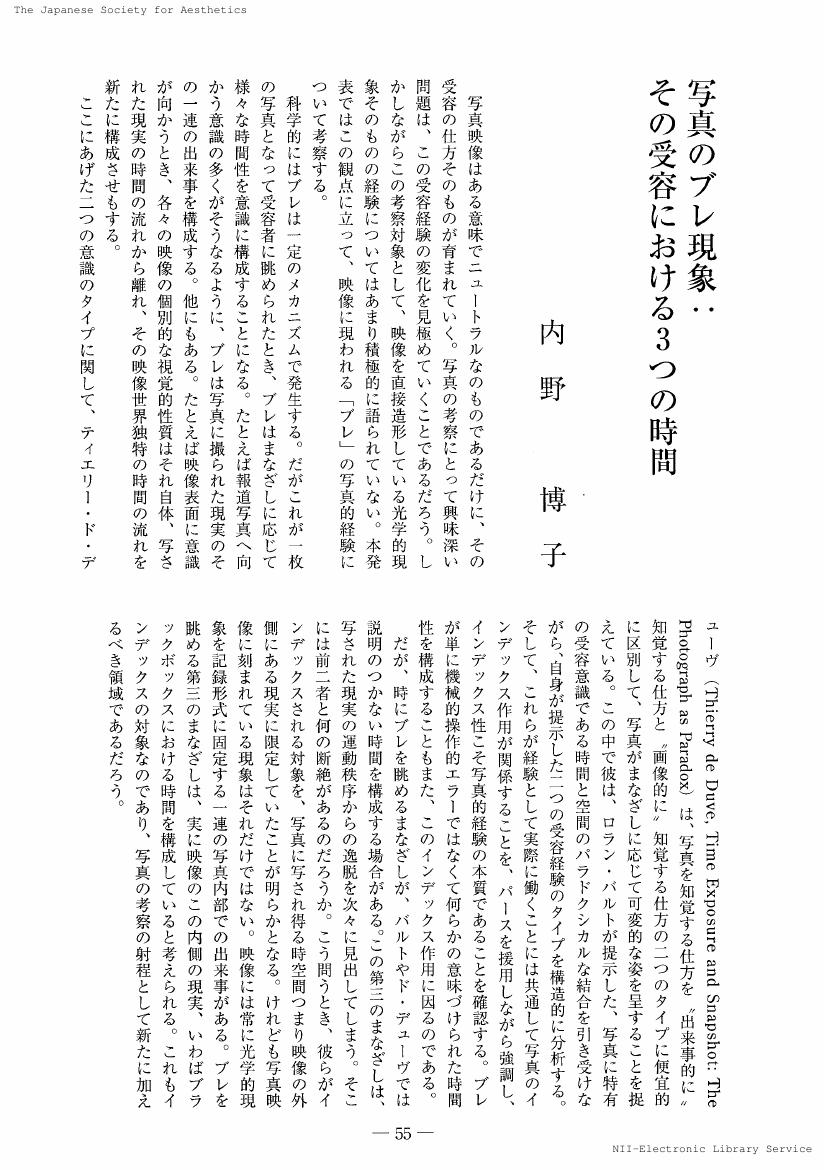- 著者
- 内野 博子
- 出版者
- 美学会
- 雑誌
- 美学 (ISSN:05200962)
- 巻号頁・発行日
- vol.61, no.2, pp.73-84, 2010
Some of Penn's experimental photographs show fluctuant blurs on unanimated objects in the work. These blurs refuse our usual mode of perceiving blurredness. Looking carefully into the nature of this refusal will therefore shed light on our usual perception of photographic images. His experiment in the shooting process consists in a fluctuant temporal-spatial relation between reality and its photographic image within a single shot. The result makes clear two important points of our usual assumption about photography: that the relation between reality and the photographic image is constant at the time of shooting, and that our usual perception of the photographic image relates it to reality only under this shooting condition, that is single moment-single focus. Jonathan Crary articulates in terms of its historical specificity the classical technique of observing modeled on camera obscura. He suggests that the intention of the classical observer determined the specific schema for perceiving objects in the world. If we may extend his theory to our case, single moment-single focus is not only the objective structure specific to the photographic image but also its subjective schema which enables us to perceive time and space of the real world through the image by quantifying them.
- 著者
- 内野 博子
- 出版者
- 美学会
- 雑誌
- 美学 (ISSN:05200962)
- 巻号頁・発行日
- vol.61, no.2, pp.73-84, 2010-12-31 (Released:2017-05-22)
Some of Penn's experimental photographs show fluctuant blurs on unanimated objects in the work. These blurs refuse our usual mode of perceiving blurredness. Looking carefully into the nature of this refusal will therefore shed light on our usual perception of photographic images. His experiment in the shooting process consists in a fluctuant temporal-spatial relation between reality and its photographic image within a single shot. The result makes clear two important points of our usual assumption about photography: that the relation between reality and the photographic image is constant at the time of shooting, and that our usual perception of the photographic image relates it to reality only under this shooting condition, that is single moment-single focus. Jonathan Crary articulates in terms of its historical specificity the classical technique of observing modeled on camera obscura. He suggests that the intention of the classical observer determined the specific schema for perceiving objects in the world. If we may extend his theory to our case, single moment-single focus is not only the objective structure specific to the photographic image but also its subjective schema which enables us to perceive time and space of the real world through the image by quantifying them.
- 著者
- 内野 博子
- 出版者
- 美学会
- 雑誌
- 美学 (ISSN:05200962)
- 巻号頁・発行日
- vol.60, no.2, pp.168-169, 2009-12-31 (Released:2017-05-22)
1 0 0 0 OA 写真のプレ現象 : その受容における3つの時間(第五十六回美学会全国大会発表要旨)
- 著者
- 内野 博子
- 出版者
- 美学会
- 雑誌
- 美学 (ISSN:05200962)
- 巻号頁・発行日
- vol.56, no.3, pp.55, 2005-12-31 (Released:2017-05-22)

